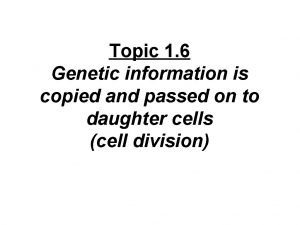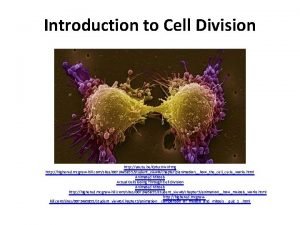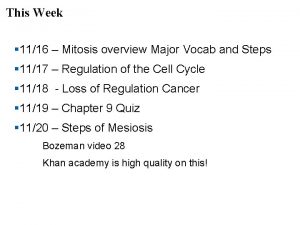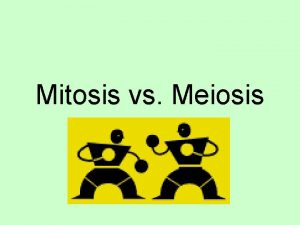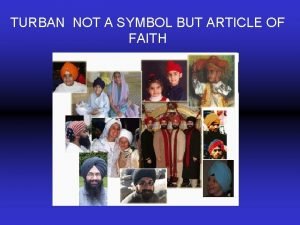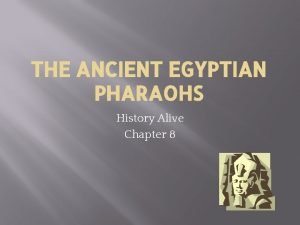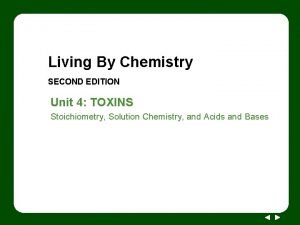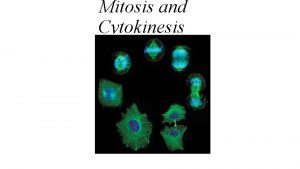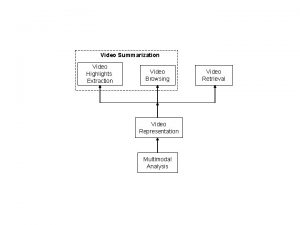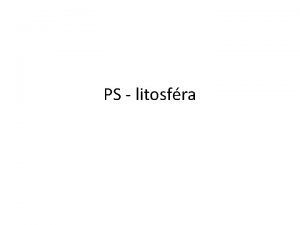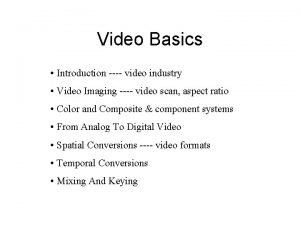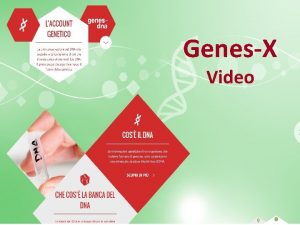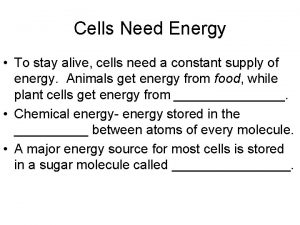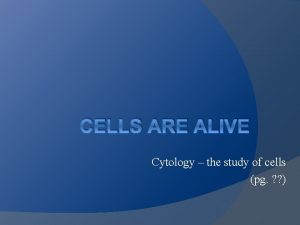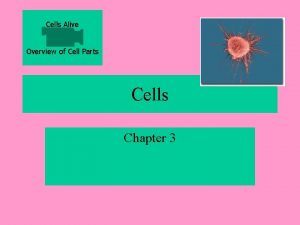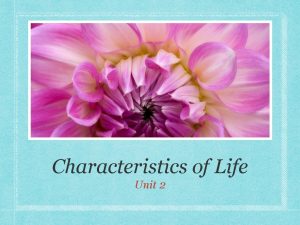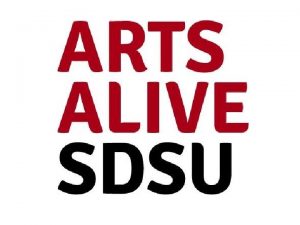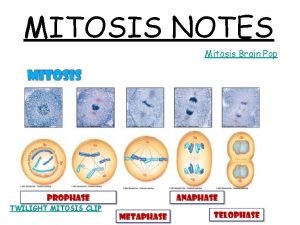Mitosis Review Cells Alive Video of Mitosis Mitosis










































- Slides: 42

Mitosis Review Cell’s Alive Video of Mitosis * Mitosis cell division. Ex: skin cells make skin cells, liver cells make liver cells, blood cells make blood cells) 2 daughter cells. * One cell duplicates all of its DNA and Organelles to become_______ * Are the Daughter Cells Identical to each other? Yes * How are they identical to each other? They have the same DNA

Introduction to Meiosis Watch the Cells Alive Video of Meiosis: How does Meiosis differ from Mitosis? 2 cell divisions 4 daughter cells produced Chromosomes line up in pairs (in 1 st metaphase) Meiosis: The cell division process that makes gametes (egg and sperm) Where (in your body) does Meiosis occur? Females: Ovaries make eggs Egg = the female sex cell Males: Testes make sperm Sperm = male sex cell

Meiosis Background Information Most cells have 2 complete sets of Chromosomes Ex: Human cells have 46 chromosomes (23 pairs) 23 (one set) came from mom’s egg 23 (one set) came from dad’s sperm How many chromosomes are in your blood cells? 46 Skin cells? 46 One from Dad Mom 2. The same chromosomes from each set are called homologous chromosomes. 3. Diploid cell (2 N) – any cell with 2 complete sets of chromosomes. Body cells are diploid. Body cells are called somatic cells. 4. Haploid Cell (1 N)- a cell with only 1 complete set of chromosomes. Sex cells ( sperm and egg) are haploid. Sex cells are called gametes.

Homologous Chromosomes eye color locus hair color locus Paternal Maternal

Meiosis and Sexual Reproduction • Sexual Reproduction requires meiosis to make gametes which join together during fertilization 46 Diploid Somatic Meiosis Occurs 23 Haploid Sperm 23 Fertilization Occurs 46 Diploid Zygote Haploid Egg mitosis • Requires male and female gametes and is usually a slower process than asexual reproduction. 446 46 Embryo

Meiosis I • Cell Division process that makes the gametes. Tetrad Prophase I: -Chromatids pair with homologous pair - forms a tetrad (4 chromatids) -Crossing over occurs – sections of DNA exchanged between homologous pairs. Metaphase I: - Tetrads line up in the middle Anaphase I: - Homologous pairs separate Telophase I: -Each Cell has identical chromatids still paired -Cytokinesis – cell divides into two

Prophase I spindle fiber centrioles

Metaphase I metaphase plate

Anaphase I

Telophase I

Meiosis II • Occurs like in Mitosis to separate sister chromatids Prophase II: - Nucleus disappears and spindle forms Metaphase II: - Chromosomes line up in the middle Anaphase II: - Chromatids are separated Telophase II: -4 cells produces -The cells are haploid cells (23 chromosomes) -Each cell is genetically different -These cells are gametes – sperm and egg

Prophase II

Metaphase II metaphase plate

Anaphase II • sister chromatids separate

Telophase II

Sexual Reproduction and Genetic Variation • Meiosis creates genetic variation in 2 ways: 1. Independent Assortment – the position of homologous pairs at metaphase I is a matter of chance. 2. Crossing Over – occurs in prophase I when genes are exchanged between homologous pairs.

Crossing Over This process can produce a chromosome that contains a new combination of genetic information from different parents that is called genetic recombination.

Meiosis in males vs. females Production of sperm cells Production of an egg cell

Mitosis Meiosis Differences Between Mitosis and Meiosis 2 daughter cells 4 daughter cells Diploid Haploid 1 cell cycle 2 cell cycles Genetically Identical Genetically Different Similarities Between Mitosis and Meiosis • Sister Chromatids pair up • Go through the same phases • Forms of Cell division

Variation • Important to population as the raw material for natural selection. • Question: What are three sexual sources of genetic variation?

Answer: 1. crossing over (prophase I) 2. independent assortment (metaphase I) 3. random fertilization Remember: variation is good!

Question: • A cell containing 20 chromosomes (diploid) at the beginning of meiosis would, at its completion, produce cells containing how many chromosomes? chromosomes

Answer: • 10 chromosomes (haploid)

Asexual Reproduction vs. Sexual Reproduction Asexual Reproduction: Sexual Reproduction: 1. Cells divide by Mitosis 2. Creates genetically identical offspring (clones) 3. Works best to create stable, unchanging environments 4. Helps a population colonize an area quickly Examples: Yeast cells – budding Bacteria – binary fission 1. Cells divide by Meiosis 2. Meiosis creates genetic variation a. Independent Assortment b. Crossing Over 3. Genetic Variation is good in a changing environment. 4. Requires male and female gametes and is slower than asexual reproduction. *Because of what happens in meiosis, the same sperm/egg will never be made twice and therefore: There never was nor will there ever be another you! You are genetically unique! (Except identical twins)

Budding - Asexual Binary Fission - Asexual Pollination - Sexual

History of Genetics Genetic Terms: • Dominant – Represented by a capital letter and masks the recessive allele. T=tall • Recessive – Represented by a lower case letter and is masked by a dominant allele. t=short • Phenotype – outward appearance of the trait. Ex. Tall • Genotype – genetic combination of the trait. Ex. TT, Tt, tt • Homozygous – genotype having the same two alleles. TT or tt • Heterozygous – genotype having two different alleles. Tt Example: T=tall and t=short TT Homozygous tall ____ tt Homozygous short ____ Tt Heterozygous tall ____

Since you have 2 alleles (different versions of a gene) for each gene, you have 2 letters TT homozygous dominant (Tall) tt homozygous recessive (short) Tt heterozygous (tall) Big letter ALWAYS wins Genotype Phenotype Combo of alleles TT Tt tt Physical trait Tall, short How do you predict what offspring will look like? • Punnett Square - tool used to predict genotype and phenotype of offspring Example: T=Tall t = short Mom – Tt Dad- Tt Cross parents Tt x Tt mom dad 1. Draw box 2. Put mom gametes on top. Put Dad gametes on side. 3. Fill in box with a letter from each parent 4. Analyze T t Phenotype Ratio: 75% Tall, 25% short TT Tt T Genotype Ratio: 25% TT, 50% Tt, 25% tt t Tt tt

Mendelian Genetics Gregor Mendel – the father of Genetics 1. Studied garden pea plants 2. He wanted to find out how traits were passed from parent to offspring.

Mendelian Genetics Mendels Experiments: 1 st Experiment: tt TT 1. Crossed two true-breeding plants. Ex. Purple flowering plant and a white flowering plant. What are the genotypes? Tt 2. This experiment produced all purple flowering plants. What are the genotypes? 2 nd Experiment: 1. Crossed two of the purple flowering plants from experiment #1. 2. Experiment produced purple flowering & white flowering plants Purple x White (P generation) All Purple Offspring (F 1 generation) ¾ purple and ¼ white flowers (F 2) Conclusions: 1. Each plant contained 2 alleles for each trait. 2. Some genes were stronger or dominant 3. Some genes were weaker or recessive


Haploid / Diploid Practice 1. If the gamete has 25 chromosomes, how many chromosomes will the body cells have? 50 2. If the somatic cells have 20 chromosomes, how many chromosomes will the sex cells have? 10 3. If the diploid number of chromosomes is 46, what is the haploid number? 23 4. If the egg cell of a mouse has 12 chromosomes, how many chromosomes will the skin cells have? 24 5. If the haploid number of chromosomes is 35, how many chromosomes will the somatic cells have? 70 6. Which type of cell division makes diploid cells? Mitosis 7. Which type of cell division makes haploid cells? Meiosis 8. How many pairs of chromosomes do humans have? 23

Mitosis Review * Mitosis ____________. Ex: skin cells make skin cells, liver cells make liver cells, blood cells make blood cells) * One cell duplicates all of its DNA and Organelles to become_______ * Are the Daughter Cells Identical to each other? _____ * How are they identical to each other? ____________

Meiosis Background Information 1. Most cells have ____________ Ex: Human cells have ___________ ___ (one set) came from mom’s egg How many chromosomes ___ (one set) came from dad’s sperm are in your blood cells? ____ skin cells? ____ One from Mom One from Dad 2. The same chromosomes from each set are called ____________. 3. ________– any cell with 2 complete sets of chromosomes. _________are diploid. Body cells are called ________. 4. _______- a cell with only 1 complete set of chromosomes. Sex cells are _____. Sex cells are called _______

Meiosis and Sexual Reproduction • Sexual Reproduction requires meiosis to make gametes which join together during fertilization Diploid Somatic Meiosis Occurs Haploid Sperm Fertilization Occurs Diploid Zygote Diploid Somatic Haploid Egg mitosis • Requires male and female gametes and is usually a slower process than asexual reproduction. 446 Embryo

Meiosis I • Cell Division process that makes the _________. Tetrad Prophase I: -Chromatids pair with _______ pair - forms a _______(4 chromatids) Spindle -_______occurs – sections of DNA exchanged between homologous pairs. Metaphase I: Anaphase I: - Telophase I: -Each Cell has identical ____________ -Cytokinesis – cell divides into two

Meiosis II • Occurs like in _______ to separate ________ Prophase II: - Metaphase II: - Anaphase II: Telophase II: -______ are produced -The cells are ______(23 chromosomes) -Each cell is genetically ______ -These cells are ______– sperm and egg

Sexual Reproduction and Genetic Variation • Meiosis creates ____________in several ways: 1. Independent Assortment – __________________ Option 1 Option 2 2. Crossing Over – _____________________________________________________ This process can produce a chromosome that contains a new combination of genetic information from different parents that is called _______________.

Mitosis Differences Between Mitosis and Meiosis Similarities Between Mitosis and Meiosis • • •

Asexual Reproduction vs. Sexual Reproduction Asexual Reproduction: Sexual Reproduction: 1. Cells divide by _____ 2. Creates genetically ______offspring (clones) 3. Works best to create _____, _____ environments 1. Helps a population colonize an area _______ Examples: Yeast cells – budding Bacteria – binary fission 1. Cells divide by ______ 2. Meiosis creates ______________ a. Independent Assortment b. Crossing Over 3. Genetic Variation is good in a ______ environment. 4. Requires _____gametes and is _____ than asexual reproduction. *Because of what happens in meiosis, the same sperm/egg will never be made twice and therefore: There never was nor will there ever be another you! You are genetically unique! (Except identical twins)

History of Genetics Genetic Terms: • Dominant – __________________ ( • Recessive – _________________ ( • Phenotype – _________________ ( • Genotype – ________________( • Homozygous – _______________ ( • Heterozygous – _________________( Example: T=tall and t=short Homozygous tall _________ Homozygous short ________ Heterozygous tall _________ ) ) )

Since you have 2 alleles (different versions of a gene) for each gene, you have 2 letters TT homozygous dominant (Tall) tt homozygous recessive (short) Tt heterozygous (tall) Big letter ALWAYS wins Genotype Phenotype How do you predict what offspring will look like? • Punnett Square - ___________________________ Example: T=Tall t = short Mom – Tt Dad- Tt Cross parents ______ x _______ 1. Draw box 2. Put mom gametes on top. Put Dad gametes on side. 3. Fill in box with a letter from each parent 4. Analyze Phenotype Ratio: Genotype Ratio:

Mendelian Genetics Gregor Mendel – ________________ 1. Studied _______________ 2. He wanted to find out how traits were passed from ______ to ___________ Mendels Experiments: 1 st Experiment: 1. ________________Ex. Purple flowering plant and a white flowering plant. 2. This experiment produced _____________ 2 nd Experiment: 1. Crossed two of the __________from experiment #1. 2. Experiment produced ________& _______plants Purple x White (P generation) All Purple Offspring (F 1 generation) ¾ purple and ¼ white flowers (F 2) Conclusions: 1. _________________ 2. _________________ 3. _________________
 My jesus is alive
My jesus is alive He's alive frankenstein
He's alive frankenstein Summary of meiosis
Summary of meiosis Paranasal sinus at birth
Paranasal sinus at birth Reabsorption
Reabsorption Pineal gland
Pineal gland Somatic vs gamete
Somatic vs gamete Somatic cells vs germ cells
Somatic cells vs germ cells Red blood cells and white blood cells difference
Red blood cells and white blood cells difference Prokaryotic v. eukaryotic cells
Prokaryotic v. eukaryotic cells Animal cell plant cell venn diagram
Animal cell plant cell venn diagram Prokaryotic vs eukaryotic cells venn diagram
Prokaryotic vs eukaryotic cells venn diagram Why did robert hooke name cells “cells”?
Why did robert hooke name cells “cells”? Masses of cells form and steal nutrients from healthy cells
Masses of cells form and steal nutrients from healthy cells Pseudostratified vs simple columnar
Pseudostratified vs simple columnar Cuál es la diferencia entre la célula animal y vegetal
Cuál es la diferencia entre la célula animal y vegetal Prokaryotic cell wall
Prokaryotic cell wall Chapter 8 cellular reproduction cells from cells
Chapter 8 cellular reproduction cells from cells Cell substance
Cell substance Video yandex b****
Video yandex b**** Video.search.yahoo.com search video
Video.search.yahoo.com search video Twvideos
Twvideos The frame size of a video refers to the video’s
The frame size of a video refers to the video’s Pmat
Pmat What kind of cells does mitosis make?
What kind of cells does mitosis make? Bone cell mitosis
Bone cell mitosis Bioflix activity: mitosis -- events of mitosis
Bioflix activity: mitosis -- events of mitosis Steamboat apush
Steamboat apush Mitosis and meiosis reflection
Mitosis and meiosis reflection Chapter review motion part a vocabulary review answer key
Chapter review motion part a vocabulary review answer key Ap gov review final exam review
Ap gov review final exam review Nader amin-salehi
Nader amin-salehi Search strategy example
Search strategy example Narrative review vs systematic review
Narrative review vs systematic review What classifies something as alive
What classifies something as alive Is a turban a religious symbol
Is a turban a religious symbol Hussain manawer poems
Hussain manawer poems Dogs in hunger games
Dogs in hunger games History alive the ancient world chapter 8
History alive the ancient world chapter 8 What is soil?
What is soil? Is peter max alive
Is peter max alive Amanda martin enron
Amanda martin enron What is catalystfive
What is catalystfive























